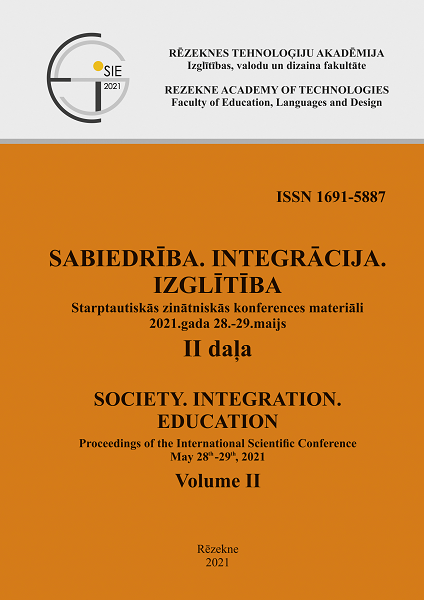THE FORMATION OF THE AESTHETIC ATTITUDE OF JUNIOR SCHOOLCHILDREN TO FOLKLORE MEANS THE INTEGRATION OF THE ARTS
DOI:
https://doi.org/10.17770/sie2021vol2.6420Keywords:
aesthetic attitude, аrt, criteria, folklore, integration, junior schoolboy, levelsAbstract
The need to form the artistic and aesthetic attitude of children to folklore and to cultivate a love of popular culture actualizes the topic of the article.
The purpose of the article is a theoretical justification for the possibility of integrating the arts as a means of forming the aesthetic attitude of junior schoolchildren to folklore; the development of a diagnostic apparatus (criteria, diagnostic techniques and levels) of the formation of the aesthetic attitude of children to folklore, the definition of the arts used in the training and their integration links.
The authors propose the structure of the aesthetic attitude of children to folklore, the criteria of its formation (motives and needs of children to study folklore, imagery, verbalization, аbstraction, symbolism, metophorization describe the results of empirical research of the original level, the exact knowledge of which will contribute to an effective change in the aesthetic attitude of junior schoolchildren to folklore.
The study is based on an analysis of philosophical and psychological-educational sources; empirical methods (pedagogical experiment, questionnaire, testing) and Methods of diagnosis of figurative and verbal development рersonality theory.
The article provides examples of the judgments of junior schoolchildren, which led to the conclusion that, that children of experimental (EG) and control groups (KG) in general, show interest in the integration of arts and are at an average (61.5% EG, and 69.2% -KG) (23.1% - EG and 19.2% (KG) or low levels of the formation of aesthetic attitude to folklore. The findings suggest that further work is needed to develop this phenomenon.
Downloads
References
Klein, S.R. (2018). Coming to Our Senses: Everyday Landscapes Aesthetics, and Transformative Learning. Journal of Transformative Education, 16 (1), 3-16. DOI: https://doi.org/10.1177/1541344617696969
Lajevic, L. (2013). Arts Integration: What is Really Happening in the Elementary Classroom? Journal for Learning through the Arts A Research Journal on Arts Integration in Schools and Communities, 9(1). Retrieved from: https://files.eric.ed.gov/fulltext/EJ1018332.pdf
Kudina, G.N. (1996). Diagnostika chitatel’skoth dejatelnosti. Moskva.
Lazareva, M.V., Lazarev, B.N. & Ovchinnikova, A.Zh. (2019). The implementation of integrated technology in teaching junior school students. Bulletin of the Cherepovets State University, 3 (90), 160-168.
Lee, L. (2019). Structuring a school around the arts can help students excel academically and develop social and emotional skills. Arts integration. Transforming a School Through Arts Integration, 8. Retrieved from: https://www.edutopia.org/article/transforming-school-through-arts-integration
Pechko, L.P. (2020). The problem of development of metaphorical imagery in artwork and creative ritings of adolessants. Revisto RN Tourismo. Estudos & Praticos. Universidado de Estado do Rio Grande do Norte/UERN-
Potemkina, O.F. (2000). Methods of diagnosis of figurative and verbal development. Personality Theory. Sankt- Peterburg: Peter.
Propp, V. (1927). Morphology of the Folktale. Trans, Laurence Scott. University of Texas Press. Retrieved from: http://www.stonedragonpress.com/wicca_201/vladimir_propp/oral_tradition_00_a.html


